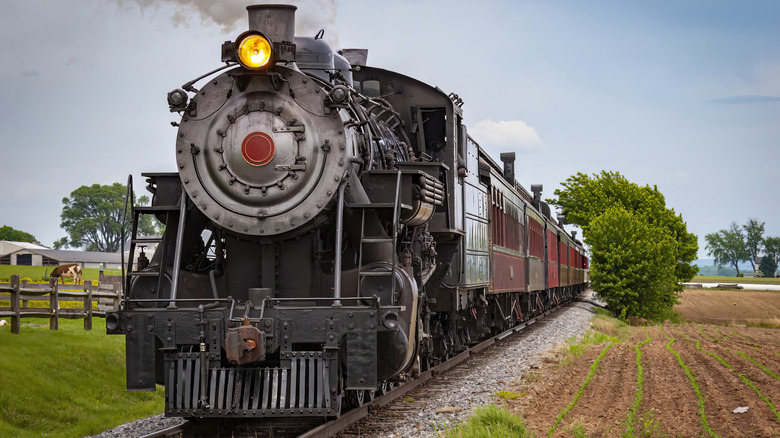Why Do Trains Have Wheels Shaped Like Cones?
Dating back to their invention in 1804, trains have been a vital mode of transportation for centuries. They are among the best inventions from the Industrial Revolution and ushered in a new era. Steam-powered locomotives steadily replaced the horse-drawn wagon trains preceding them with their ability to move heavy loads of passengers and precious cargo across the land at swift speeds using their brute horsepower. Rolling along with the advancement of modern technology, the train as we know it has seen many changes in design over the years. Perhaps one of its most important design elements is its wheel.
Have you ever noticed that the wheels of a train have a unique conical shape? You might think it's a purely aesthetic choice. And while it may lend to the overall look of the train, the shape of the wheels plays a crucial role in the train's operation, allowing it to navigate safely and smoothly on the railway. If it weren't for the wheel's cleverly-engineered design feature, the mighty train might run right off the track.
The deal with the conical wheel
The conical wheel is an innovative feat of engineering that helps the train with two main things: navigating curves and staying on the track. To understand how conical wheels work, it's important to understand why round wheels don't work. While navigating a straight track may work well enough, trying to steer a train with round wheels on a curved railroad would pose a challenge, likely resulting in the train derailing. This is because round wheels lack a self-centering force to keep them aligned with the track, especially when navigating curves.
Unlike round or cylindrical wheels, the conical shape of train wheels creates a self-centering force. The key factor is that the two sides of the wheel are different in diameter, allowing the contact point between the wheel and the track to naturally shift with the movement of the train. As the train turns, the larger side of the wheel makes contact with the track and supports its weight, while the smaller portion moves slightly faster and allows the wheel to move in the direction of the curve. (If you're having trouble picturing this, watch the YouTube video above to get a clearer visual on how it works). Essentially, if it weren't for the wheel's conical design supporting smooth movement and stability on the track, the risk of a deadly train accident would significantly increase.
Tracking the evolution of train wheels
Train wheels weren't always conical. When train transportation was still new in the early 19th century, the wheels were cylindrical and made of cast iron. Impacted by the weight of the train — made even heavier when filled with large loads of cargo — the wheels were prone to breaking, sparking the need for a stronger material. Starting in the 1830s, engineers began replacing cast iron with wrought iron, which held up much better in the long run. In the late 19th century, they made the shift to steel, an even stronger material that accommodated the growing weight and speed of trains.
Apart from what they were made of, the shape of early train wheels caused another common problem: wobbling. Because of the wheel's cylindrical shape, as the train turned, it would sway from side to side. This inspired the use of the flanged wheel. Invented by Englishmen William Jessup in 1789, the flanged wheel was originally built for early-day wagon trains, helping them grip onto the rails with their innovative rimmed design. Adding the flanged element to train wheels put a stop to the wobbling, ensuring the train's overall stability on the track.
Later elaborating on the flanged wheel design, railway pioneer George Stephenson implemented the use of the conical wheel in 1814. This further revolutionized the way trains navigated the railroad. To this day, conical wheels are a staple of locomotive design, allowing trains to smoothly chug around curves and stay on track.

